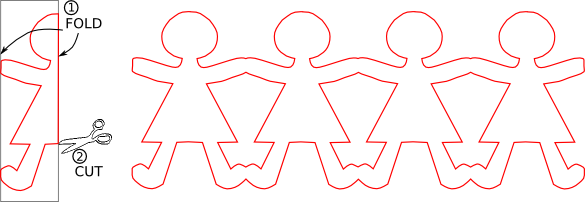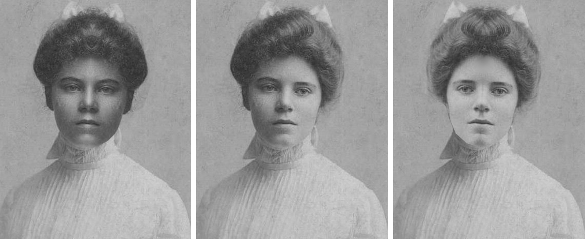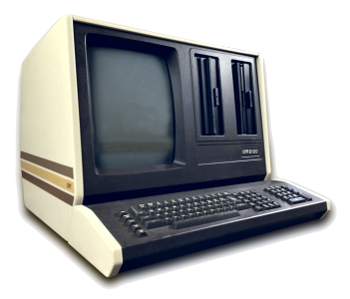CPT Symmetry
October 29, 2015
In my
childhood, I enjoyed cutting out
paper dolls. Lest you wonder about such an early transcendence of
gender stereotyping, these were not the
dress-up type of paper dolls beloved by girls. Rather, these were fold-and-cut paper dolls in which a piece of
paper with multiple folds, when cut in a certain way, would yield a
daisy chain of figures, as shown below.

An example of a daisy chain of fold-and-cut paper dolls. (Created with Inkscape.)
This process was applicable, also, to other shapes, such as
angels,
snowflakes,
hearts, and
Christmas trees, the later rendered
vertically to allow for a linkage between items. Cutting out paper dolls is one of the
arts-and-crafts activities stereotypically given to
mental patients to keep them busy, so this might have been good practice for a
career as a "
mad scientist," In actuality, it was good training in the
mathematical concept of
symmetry.
Humans are exposed to symmetry from
birth though observation of
nature.
Plants and
animals exhibit approximate symmetries, such as
radial symmetry and
bilateral symmetry. An example of human bilateral symmetry can be seen in the following figure.

A photograph of American suffragette, Alice Paul (1885-1977), center, has been processed into two images in which each half of her face has been replaced with a mirror image of the the other side. This illustrates the approximate bilateral symmetry of the human body. (Source image, via Wikimedia Commons.)
Aside from these visual aspects of symmetry, there are deeper
mathematical definitions of symmetry. Some of these, such as the concepts of
even and odd functions and
symmetric polynomials, are even accessible to secondary school students. Where there's math, there's usually some associated
physics, and physics has
its own symmetries.
When looking at isolated objects where
thermodynamics and the concept of
entropy is not an issue, we can make a
video of a
particle being acted upon by
forces, play the video backwards, and the
laws of physics as inferred from this backwards playback are no different than those in the actual case. This is known as
time-reversal symmetry. likewise, we can view what's happening in a
mirror, and nothing would seem amiss. This is
parity-inversion symmetry.
There is also a
charge-conjugation in which every particle is replaced by its
antiparticle. The antiparticles have a charge of opposite sign to normal particles. Just like the approximate symmetry of the human face, these symmetries are almost true, just not always true. A
1956 experiment involving the beta decay of cobalt-60 showed that parity was not always conserved. This meant that it was possible to have an
experiment distinguish
left from right.
.jpg)
Life among the beamlines.
Physicist, Chien-Shiung Wu (1912-1997), in a 1963 photograph. Wu proved parity violation in a 1956 experiment.
(Portion of a Smithsonian Institution Archives image, Accession No. 90-105, via Wikimedia Commons.)
While parity was not conserved, it was thought that a combined charge-parity (CP) symmetry was still true in all cases. It was not long before
CP violation was found.
James Cronin and
Val Fitch found CP violation in
neutral kaon decay in 1964, a discovery that resulted in their winning the 1980
Nobel Prize in Physics. CP violation may explain why
our universe is made of matter and not an equal mixture of matter and antimatter.
Theoretical physicists, now with their
backs against the wall, decided that everything is explained when you simultaneously invoke all three symmetries; that is,
CPT symmetry. According to CPT symmetry, an antimatter universe (C) that's a mirror image of our own (P) in which particle
momentum is reversed (T) would have the same laws of physics that we observe. The
experimentalists have taken up the challenge to see whether CPT symmetry is violated in some cases. At this point, no violation has been discovered.

A CPT of another sort.
Some of my early scientific papers were rendered on a CPT 8100, as shown. This word processor, manufactured by the CPT Corporation in the early 1980s, used an 8080 microprocessor.
(Via Wikimedia Commons.)
In their continued checks for CPT violation, experimentalists have brought out the heavy guns in the form of the
Large Hadron Collider (LHC).
Scientists on the
ALICE (A Large Ion Collider Experiment) team at the LHC have just published results on their study of the
mass-to-charge ratio of
helium-3 nuclei and
deuterium nuclei, along with that of their respective antiparticles.[1-3] This follows an experiment at
CERN's Antiproton Decelerator that looked at the charge-to-mass ratio of
protons and
antiprotons.[4-5]
While the ALICE experiment was not specifically dedicated to test CPT invariance, physicists take their opportunities where they can. In the experiment, the ALICE team measured the difference between the ratios of the mass and charge of deuterons and anti-deuterons generated by
Pb–Pb collisions at 2.76 TeV. The collision of
lead ions provides an abundant source of particles and antiparticles at nearly equal rates.[3] ALICE is a high precision
time-of-flight detector with a resolution of 80
picoseconds that provided a clear indication that CPT violation is unlikely.[3]
The earlier, CERN experiment captured antiproton and hydrogen ion pairs in a
Penning trap and measured their
cyclotron frequency. This measurement allowed a close determination of the charge-to-mass ratio. The research team was able to measure about 6,500 pairs over a 35-day period.[5] They found that the charge-to-mass ratio is identical to within just 69
parts per trillion, which is evidence that CPT is not violated.[4-5] The CERN team has plans to increase the precision of their measurements by one or two
orders of magnitude.[5]
References:
- ALICE Collaboration, "Precision measurement of the mass difference between light nuclei and anti-nuclei," Nature Physics (August 17, 2015), doi:10.1038/nphys3432. This is an open access article with a PDF file here.
- CERN: Most precise measurement of mass and charge of light nuclei and anti-nuclei, Technical University of Munich Press Release, September 2, 2015.
- Diego Freire, "Experiment confirms fundamental symmetry in nature," São Paulo Research Foundation, September 16, 2015.
- S. Ulmer, C. Smorra, A. Mooser, K. Franke, H. Nagahama, G. Schneider,T. Higuchi, S. Van Gorp, K. Blaum, Y. Matsuda, W. Quint, J. Walz, and Y. Yamazaki, "High-Precision Comparison of the Antiproton-to-Proton Charge-to-Mass Ratio", Nature, vol. 524, no. 7564 (August 13, 2015), pp. 196-199, doi: 10.1038/nature14861. This is an open access article with a PDF file here.
- Protons and antiprotons appear to be true mirror images, RIKEN Press Release, August 13, 2015.
Permanent Link to this article
Linked Keywords: Childhood; paper doll; gender role; gender stereotyping; dress-up; paper; garland; daisy chain; Inkscape; angel; snowflake; heart; Christmas tree; vertical direction; vertically; handicraft; arts-and-crafts activities; stereotype; stereotypical; mental disorder; mental patient; career; mad scientist; mathematics; mathematical; symmetry; human; birth; nature; plant; animal; symmetry in biology; radial symmetry; bilateral symmetry; American; suffragette; Alice Paul (1885-1977); face; mirror image; human body; Wikimedia Commons; symmetry in mathematics; even and odd functions; symmetric polynomials; physics; thermodynamics; entropy; video; particle; force; physical law; laws of physics; time; mirror; parity; charge; antiparticle; Wu Experiment; beta decay; cobalt-60; experiment; relative direction; beamline; physicist; Chien-Shiung Wu (1912-1997); parity violation; CP violation; James Cronin; Val Fitch; neutral kaon; radioactive decay; Nobel Prize in Physics; baryogenesis; theoretical physics; theoretical physicist; back against the wall; CPT symmetry; momentum; experimentalist; scientific literature; scientific paper; word processor; CPT Corporation; Intel 8080 microprocessor; Large Hadron Collider (LHC); scientist; ALICE (A Large Ion Collider Experiment); mass-to-charge ratio; helium-3 nuclei; deuterium nuclei; CERN; >Antiproton Decelerator; proton; antiproton; Pb; lead; ion; time-of-flight detector; picosecond; Penning trap; cyclotron resonance; cyclotron frequency; parts per trillion; orders of magnitude.